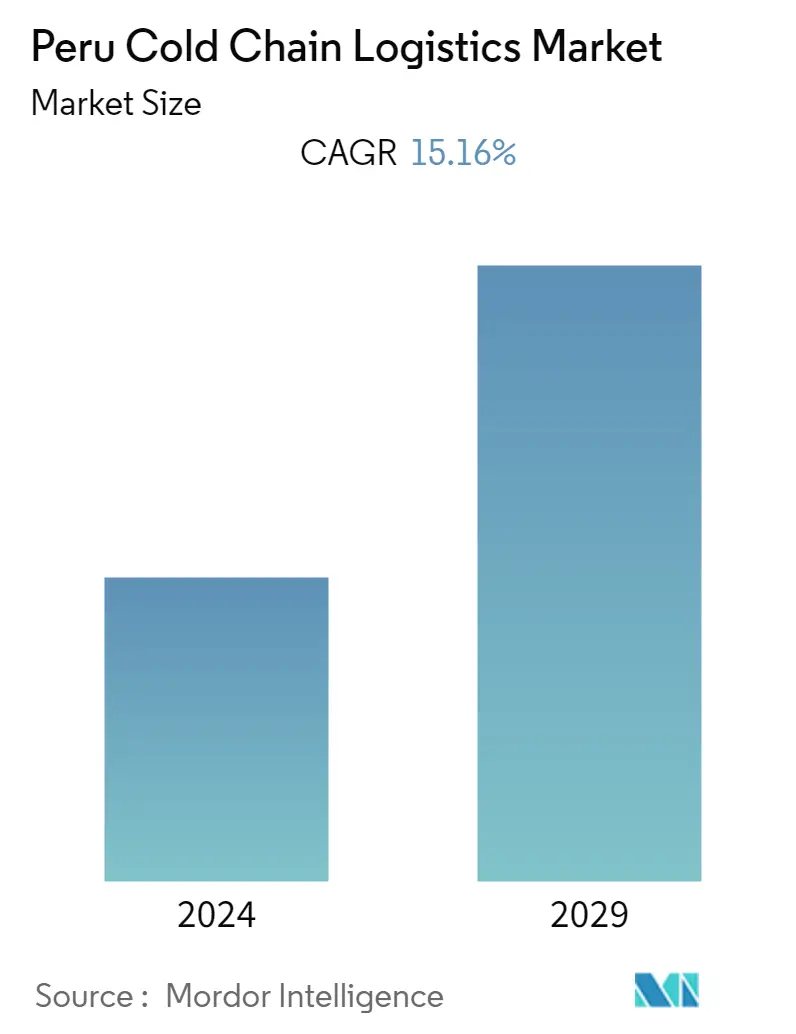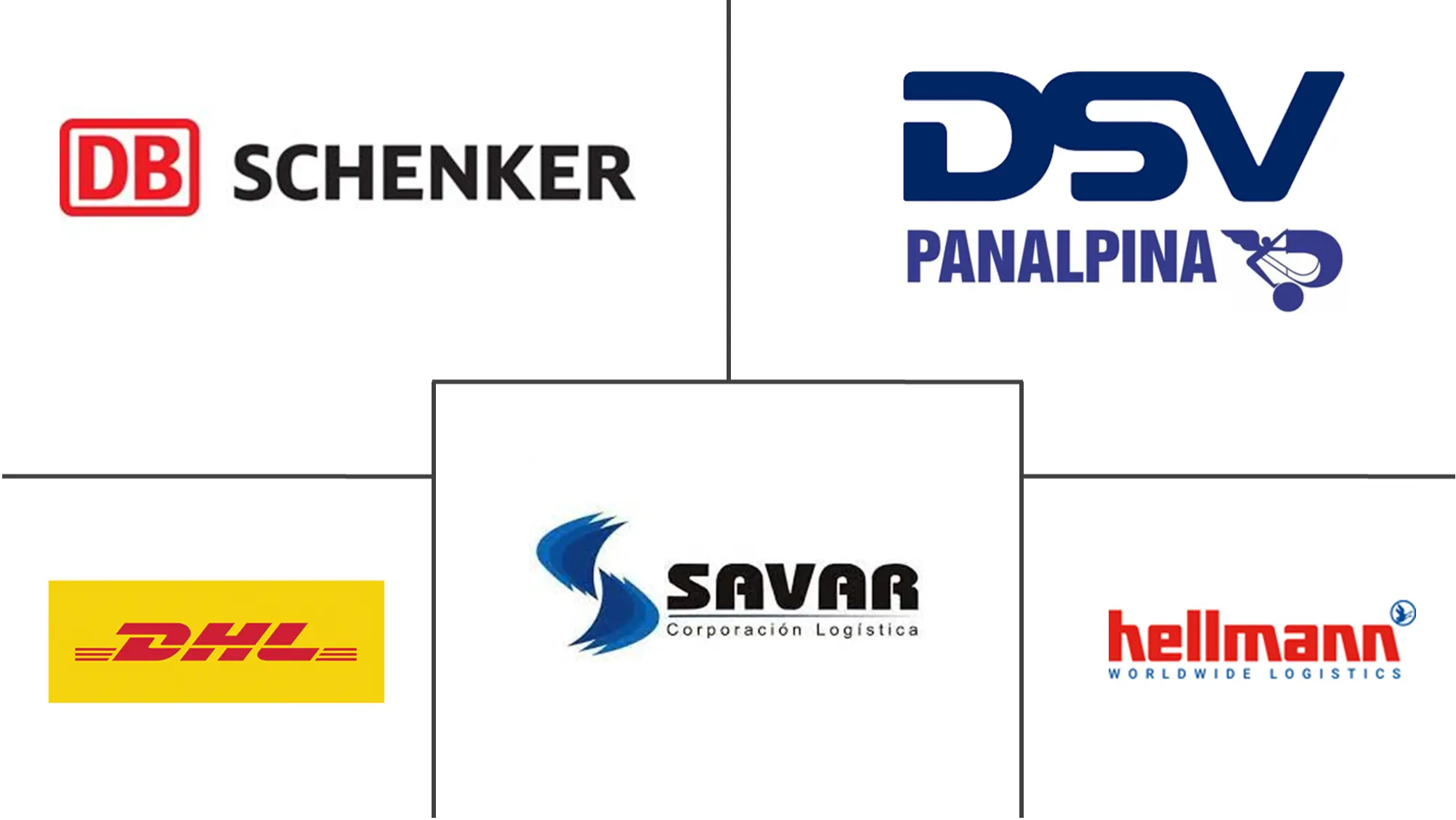Market Size of Peru Cold Chain Logistics Industry

| Study Period | 2020 - 2029 |
| Base Year For Estimation | 2023 |
| Forecast Data Period | 2024 - 2029 |
| Historical Data Period | 2020 - 2022 |
| CAGR | 15.16 % |
| Market Concentration | Low |
Major Players
*Disclaimer: Major Players sorted in no particular order |
Peru Cold Chain Logistics Market Analysis
The cold chain logistics market in Peru was valued at USD 119.5 million in 2020, and it is expected to reach USD 278.78 million by 2026, registering a growth rate of 15.16% during the forecast period.
The Peruvian cold chain logistic market is in developing phase where the government is understanding the importance of cold chain supply and working on building more temperature controlled warehouses. Also, with low supermarket pentration in the country, there is a potential growth for the sector.
With outburst of Covid-19, people switch to online mode and thus an exponential growth is recorded for business switching to online mode. Fresh food demand during the lockdown kept the cold chain logistics in business while exports of fruits and vegetables, one of the most exported item in Peru, also returned to their usual export figures i.e pre-pandemic. Also, the vaccines against corona virus is required to be kept at low temperatures, thus driving the demand of cold chain logistics market in country.
The food service industry accounts for up to 18% of total foreign tourist revenue. Peru has around 20,000 hotels with about 500,000 bedrooms. High-end restaurants and hotels serve high-value consumer-oriented products from the United States (such as wines, cheese, beef, and pork), which necessitates the use of cold storage warehouse space.
The food processing industry in Peru is a thriving area of the country's economy. Peru's food business contributes for over 28% of the country's industrial GDP, with a gross value added of USD 9.4 billion in 2020.
Peru Cold Chain Logistics Industry Segmentation
Cold Chain Logistics comprises establishments primarily engaged in operating refrigerated warehousing, storage facilities and transportation of goods in temperature controlled vehicles. The services provided by these establishments include blast freezing, tempering, and modified atmosphere storage services. A complete background analysis of the Peruvian Cold Chain Logistics market, which includes an assessment of the economy, market overview, market size estimation for key segments, and emerging trends in the market, market dynamics, and key company profiles are covered in the report.
| By Service | |
| Cold Storage/Refrigerated Warehousing | |
| Refrigerated Transportation | |
| Value-added Services (Order Management, Blast Freezing, Labeling, Inventory Management, etc.) |
| By Temperature Type | |
| Chilled | |
| Frozen |
| By End User | |
| Fruits and Vegetables | |
| Dairy Products (Milk, Butter, Cheese, Ice Cream, etc.) | |
| Fish, Meat, and Seafood | |
| Processed Food | |
| Pharmaceutical (Includes Biopharma) | |
| Bakery and Confectionery | |
| Other End Users (Chemicals, etc.) |
Peru Cold Chain Logistics Market Size Summary
The cold chain logistics market in Peru is in a developing phase, with the government recognizing the significance of temperature-controlled supply chains and working to expand infrastructure such as temperature-controlled warehouses. The market is poised for growth due to the low penetration of supermarkets, which presents opportunities for sector expansion. The COVID-19 pandemic accelerated the shift to online business models, boosting demand for cold chain logistics to support fresh food supply and maintain export levels of fruits and vegetables. The need to store and transport vaccines at low temperatures further drives the market, highlighting the critical role of cold chain logistics in the country.
The food service and processing industries are significant contributors to Peru's economy, with the former relying on cold storage for high-value imports and the latter being a major part of the industrial GDP. The pharmaceutical sector, characterized by intense competition and digital transformation, also relies on cold chain logistics for the distribution of temperature-sensitive products. Peru's agricultural sector, a major exporter of fruits and vegetables, benefits from improved logistics to reduce food wastage. The market is fairly consolidated, with key players investing in technology to gain a competitive edge. Recent developments include infrastructure expansions and new storage facilities, indicating ongoing growth and modernization in the cold chain logistics sector.
Peru Cold Chain Logistics Market Size - Table of Contents
-
1. MARKET INSIGHTS
-
1.1 Current Market Scenario
-
1.2 Technological Trends
-
1.3 Government Regulations
-
1.4 Value Chain / Supply Chain Analysis
-
1.5 Insights on Refrigerants and Packaging Materials
-
1.6 Brief on Freight Rates
-
1.7 Impact of COVID-19 on Peru's cold chain logistics market
-
-
2. MARKET SEGMENTATION
-
2.1 By Service
-
2.1.1 Cold Storage/Refrigerated Warehousing
-
2.1.2 Refrigerated Transportation
-
2.1.3 Value-added Services (Order Management, Blast Freezing, Labeling, Inventory Management, etc.)
-
-
2.2 By Temperature Type
-
2.2.1 Chilled
-
2.2.2 Frozen
-
-
2.3 By End User
-
2.3.1 Fruits and Vegetables
-
2.3.2 Dairy Products (Milk, Butter, Cheese, Ice Cream, etc.)
-
2.3.3 Fish, Meat, and Seafood
-
2.3.4 Processed Food
-
2.3.5 Pharmaceutical (Includes Biopharma)
-
2.3.6 Bakery and Confectionery
-
2.3.7 Other End Users (Chemicals, etc.)
-
-
Peru Cold Chain Logistics Market Size FAQs
What is the current Peru Cold Chain Logistics Market size?
The Peru Cold Chain Logistics Market is projected to register a CAGR of 15.16% during the forecast period (2024-2029)
Who are the key players in Peru Cold Chain Logistics Market?
DHL, Savar Logistica, Frialsa Frigorificos, Depsa and Absolute Zero are the major companies operating in the Peru Cold Chain Logistics Market.

